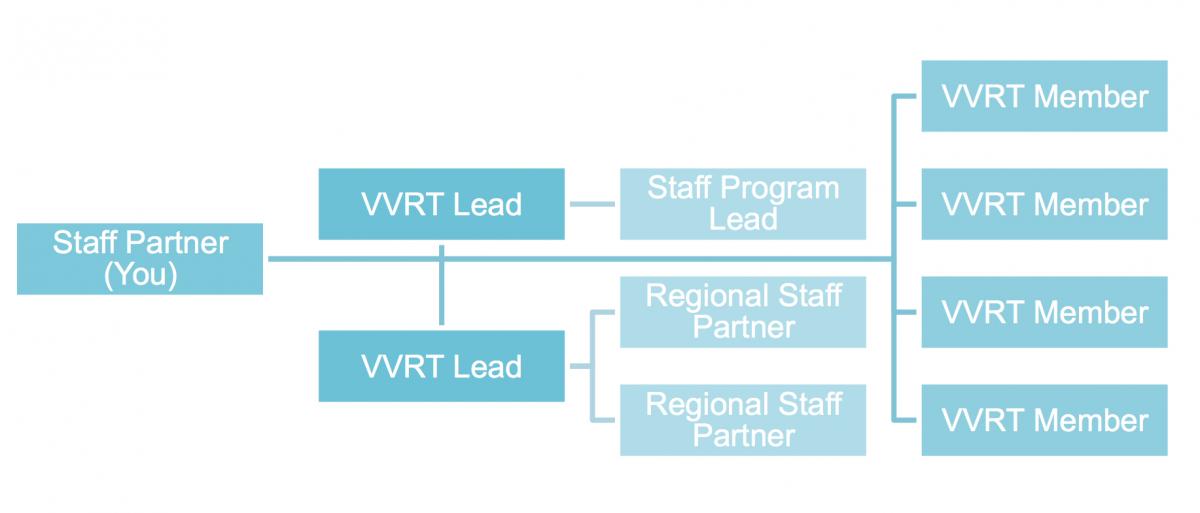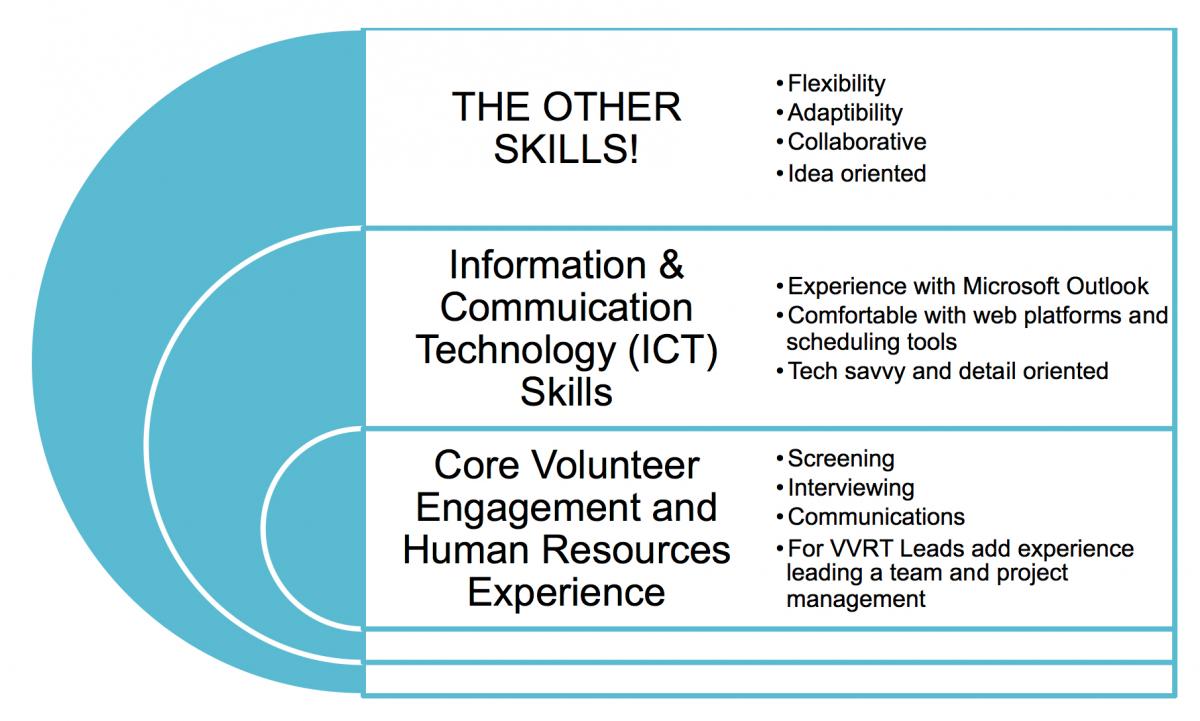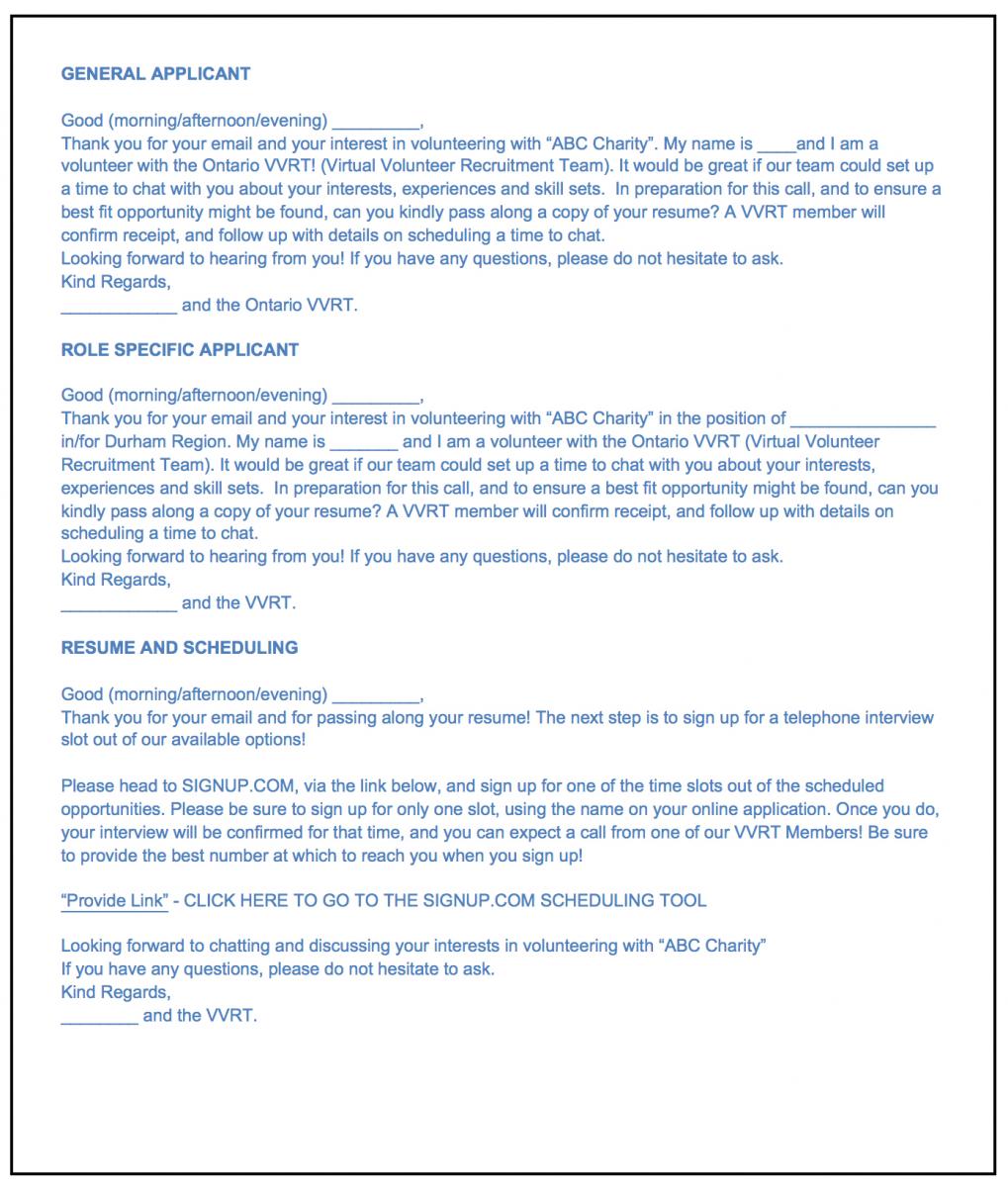Virtual Volunteer Recruitment Teams: Considerations, Tools, and Training for Success

Recruitment is an integral and seemingly never-ending part of the success of volunteer engagement departments in almost every organization. But when this task is being coordinated by one person sitting in an office space, it can sometimes feel like an impossible job, in large and small organizations alike.
After planning, recruitment is the first action stage of the volunteer cycle, and also the applicant’s first chance for a good experience with your organization. No wonder it’s something that so many of us hold so closely and is often an area excluded from volunteer involvement. Thinking about engaging volunteers to help support volunteer recruitment in your organization can be intimidating – and, granted, those anxious feelings might increase if the volunteers added are virtual. But that doesn’t have to be the case.
This Training Designs explores every facet of creating a Virtual Volunteer Recruitment Team (VVRT), including: what a VVRT can look like; what goes into finding the right candidates to fill the roles; the technology and tools that make operations easier; the nuances of communications and training; and how best to ensure your VVRT volunteers stay engaged and happy with their roles and your organization.
THE DEFINITION OF VIRTUAL VOLUNTEERING
Before we examine what it looks like to build a VVRT, let’s quickly review the definition of virtual volunteering.
Virtual volunteering can include activities from locations remote to the organization or the people they are assisting. It can be also be referred to as online volunteering or e-volunteering. It takes place or is facilitated via a computer or other Internet-connected device.1
When it comes to VVRTs, we need to think about some of the specific requirements necessary to meet the conditions for success.
WHAT A VIRTUAL VOLUNTEER RECRUITMENT TEAM CAN LOOK LIKE
Depending on your specific needs, the model below can be tweaked for the program your recruitment team is concentrated to, or expanded to include support for various organizational departments. This example reflects a virtual volunteer recruitment team from Ontario, Canada that supported province-wide recruitment cycles throughout the year in multiple program or geographic areas.

VVRT Member – These are the volunteer members of your recruitment team who are in direct communications with volunteer applicants throughout the screening process. It is a fluid role that requires great attention to detail and a great deal of flexibility. In addition to communicating with volunteer applicants, the VVRT Member also provides detailed reports to the VVRT Leads and assists with placement and role suggestions based on the skills and experiences of each applicant.
VVRT Lead – There can be one or two of these positions depending on the volume and size of the team. VVRT Leads are leadership-level volunteers with the capacity to oversee and manage a team of volunteers, have the operational and communication skills to work with multiple staff partners or program leads, and have a close, working relationship with you as their direct Staff Partner. You can divide these volunteers up into program areas or between the staff they support, depending on what you are recruiting for. The VVRT that I worked with had two VVRT Leads. One focused on working with Regional Development Staff to fill recruitment needs for local leadership volunteers involved in signature fundraising event committees as well as Chapter executive members. The other Lead worked with designated staff and departments in our national office that managed various programs that involved volunteers, including Public Policy and Advocacy, Education and Youth Services as well as Marketing and Communications. Both VVRT Leads had regularly recurring phone meetings with the staff they worked with to keep the volunteer cycle moving forward for applicants.
Staff Partner (You) – At first glance it might look like the entire VVRT model is daunting and overwhelming. But it wasn’t nearly as overwhelming as trying to keep up with the volume of applicants and providing a high level of customer service, all while juggling the other pieces of the volunteer cycle beyond screening and my other regular responsibilities. By building this team – and having open lines of communication with all its members, as well as the infrastructure to check in and oversee the processes – the VVRT model created much more capacity for me as a leader of volunteers. Not only was I better able to do my job, the VVRT model increased recruitment success for volunteer vacancies, allowed for other new projects to get underway, and improved various program outcome areas and increased revenue streams.
THE SKILLS & EXPERIENCE YOU LOOK FOR
When building your VVRT, there are multiple skill sets you look for. Namely, both the concrete skills in terms of experience, and then the additional characteristics that will make for the right fit for the VVRT working circumstances. Let’s look at the visual below:

As volunteer engagement professionals, we are experienced with writing position descriptions as well as screening and interviewing for the right candidates. The core skills that members of the VVRT need are represented by the two smaller circles, while the characteristics beneficial in each member of the team are represented under the largest circle “The Other Skills.” There are ways to broach these realities and assess for these characteristics during the screening process, but I found in some cases, it wasn’t 100 percent clear whether the VVRT candidate had all the skills, capacity, and interests for these realities until the training, orientation, and even supervision stages – AND THAT IS OK! The most important thing to remember when developing something new or piloting a project is the management of expectations. As long as you have been clear from the start that there will be some growing pains and changes to the process as your pilot is developed, it is alright as the Staff Partner to to re-evaluate the fit and assignment of the VVRT volunteers.
TOOLS & TECHNOLOGY
Virtual volunteer recruitment teams can be successful if given the opportunity to collaborate as a functioning unit through utilizing various Information and Communication Technologies (ICT Technology) platforms. The model presented above operated in a real-time continuum, where one VVRT Member would pick up from where another one left off while keeping the experience for the applicant timely and efficient (more to come on how to do this below). In order to ensure this was possible, there were various ICT Technology platforms necessary to make that happen, from the application process to communication practices, scheduling tools, and reporting procedures. These included the following:
Shared email account
This was an organizational email (ex: VVRTOntario@ABCCharity.ca) as opposed to a public platform account, such as a @gmail or @yahoo account. As the Staff Partner that lead the VVRT, this email was part of my Outlook inbox, and I could see all the communications; I could jump in and respond when necessary from this email or at the request of a member of the VVRT, which allowed for a smooth communication stream for our applicants. Through the technology available via our organizational application, we were able to have new volunteer application alerts come to this email, so the team could work in live time as they came in.
Scheduling platform for interviews
If you don’t have scheduling software utilized by your own organization, you can take advantage of excellent free resources such as signup.com. Signup.com was an effective way for the VVRT to manage scheduling their shifts and applicant interviews. We had one VVRT Lead manage the calendar on signup.com, with each respective VVRT volunteer’s shift availability on a four-week cycle, and then applicants could select an interview time from the calendar. Once a slot was filled, it would be blocked off, so there were never any duplicates or conflicts. Each VVRT shift block was two hours, and the first hour was for communications and resume review, while the second hour was broken into two half hour blocks for interviews. The members of the VVRT had varying availability between daytime and evening and weekends, so we could meet the needs of all applicants.
Shared files tracker
While some organizations might have the capacity to have virtual volunteers access a shared platform or server, our organization did not. So we established a shared Google Drive for our working documents and progress tracking. This required creating a @gmail address, which was not used for any external communication, just internal sharing and login procedures to the Google Drive.
A great resource for assessing the needs of ICT Technology in virtual volunteer projects is Yvonne D. Harrison’s two-part interview that was featured in the April and July of 2007 issues of e-Volunteerism. In part two entitled “Managing Virtual Volunteers: A Model for Decision Making,” Harrison presents a logic-model to assess the use of technology in virtual volunteering and offers the following idea: "The use or uses of technology in virtual volunteerism can be shaped and defined as experience with technology grows” and she promotes that within a pilot project there should be continuous cycles of learning.2 This was definitely the case for the VVRT that I worked with, as we were regularly updating our operations and methods to work with the technology we had available, and the emerging needs that developed as we progressed with our operations.
COMMUNICATIONS
As mentioned above, the communication abilities of the volunteers on the VVRT are just as vital as their skills and experience with screening and interviewing. For consistency (with the additional benefits of speed and convenience), many of the initial communications used were on a template, depending on the applicant type and step in the process. But as we all know, when working with applicants there is always the need to adapt and to be able to integrate answers to questions at various times in the communication process.
Master Tracking Sheet
The VVRT Master Tracking Sheet was what kept our group functioning and in order. It was the key piece to our operations.
The Master Tracking Sheet is an excel spreadsheet (see attachment here). It contains information that is based on details available from the online application form, and also indicates where volunteers are in the application process. This allows VVRT volunteers to keep organized and to stay on track in order to understand where to pick up and begin on their shifts. "Status" refers to where the applicant was in the process, and we used a drop-down menu that was streamlined and easy to identify. There is a "Notes" section in our Master Tracking Sheet for the feedback that can result from an interview, but we captured additional findings in our shift reports, which were developed as our volume increased.
A Sample VVRT Shift
Here's what a sample VVRT shift can look like:
HOUR 1
- Check shared inbox and update the Master Tracking Sheet – with any new applicants (with status)
- Communications:
A. Acknowledge Volunteer Application Options
a. General Applicant
b. Role Specific Applicant
c. Event Day Applicant
B. Collect Resume
C. Confirm receipt of resume and share interview scheduling procedures
HOUR 2
Phone Screening – When there were interviews booked, the VVRT Member would complete interview questions and update the Master Tracking Sheet to reflect the outcome of the call.
At the start of the VVRT operations, if there were no calls booked, the volunteer shift ended early. As the operations progressed, we analyzed what other needs existed. We then began using the second hour for placement check in emails and follow-ups with volunteers who had earlier gone through the VVRT for placement.
See the image below for a sample of what the communications template looked liked for the initial communication stage described above. All of these communications were sent from the shared email address that the VVRT used – VVRTOntario@ABCCharity.ca .

Along with the resources mentioned above, we created templates for shift reports and interview summary reports that each VVRT member would save and share on our Google Drive, and then send an email to the team where they left off. The content needed in these templates, I must admit, was a work in progress. As the VVRT got started, the members of the team helped to create the documents that they felt worked for their needs – more details in some places, less in others, and additional ways to capture, summarize, and review content. For example, one suggestion was a quick-glance grid for general applicants’ skills and interests in various areas. This was developed from the screening and interviewing experiences of one of the VVRT members and gladly adopted by all.
TRAINING A VVRT
When establishing a VVRT, you need the usual suspects when it comes to training resources, and then you need to think outside the box and adapt to the nuances of the team and the resources you might have available to you. Remember: it is an entirely different experience to connect virtually, and sometimes it is easy to forget the personal touch that can go a long way and comes easily when connecting with someone in person. (Hopefully these next two sections will provide you with some tips to help combat this obstacle!)
I absolutely suggest that the following resources to be part of your orientation and training arsenal: Virtual Orientation, a VVRT Manual, and Conference and Skype calls.
First, VVRT ORIENTATION. After your initial organizational volunteer orientation, be sure to develop a specific VVRT Orientation that includes the WHO, WHAT, WHERE, WHY, and HOW of the idea, the reason behind establishing the team, and a high-level overview of how it will operate.
Second, a VVRT MANUAL. This document is more procedural and will cover processes, platforms, templates, examples, contacts, and login information. Think of it as a one-stop shop for members of the VVRT to reference. Keep in mind, though, that it will likely be a fluid and changing document as your team gets off the ground and begins to operate and fall into a working groove and processes are refined and tweaked.
Third, CONFERENCE and SKYPE CALLS. Make them an ongoing thing! While they are often considered a “go to” at the start of a project or to begin training, why stop there? While being respectful of the time your VVRT has available, I suggest periodic team check-ins and the chance to connect screen-to-screen when face-to-face isn’t possible. This is not only a great way to train on any new elements or adjustments to your operations but also a great way to keep the members of your VVRT feeling engaged and connected when working behind a virtual screen.
HOW TO KEEP THE VVRT ENGAGED AND CONNECTED
When considering how to keep the VVRT engaged and feeling connected, here are some key factors to incorporate and use:
- INTRODUCTIONS: Introduce team members to one another and staff. Introducing volunteers to one another - and including a photo, a brief bio, and the role/shift they’ll be doing - really helps to connect people who don’t have the luxury of walking down the hall to introduce themselves. It also provides a legitimacy to the team and sets the tone to staff working with them that these are important colleagues who will be playing a key role in supporting them.
- SNAIL MAIL: Just because you are being technologically savvy with the operations of your VVRT, don't dismiss a tried and tested method of communication. Think of creative ways to share hardcopy examples, training tools or resources, or an old-fashioned thank you card via the mail. It could be a cycle of pieces mailed between team members or a note coming from you, but who doesn’t love mail that isn’t a bill?!
- CALLS WITH COLLEAGUES: Think of creative ways your VVRT can share in their successes! Invite them to participate in larger team updates or meetings via conference call. It is not only a chance to have them explain how things are working with the VVRT to a broader audience, but it is also a great chance to have them learn about different areas of the organization at the same time! Harrison mentioned in her interview that making volunteers who have been successful into champions or virtual volunteer mentors is important because of the “vicarious experience factor” and the results can be that others will be more likely to want to try.3
- EXTEND AN INVITATION: If possible, extend the invitation to an organizational event that might be taking place in their area. The VVRT that I worked with was spread out across Ontario, but in all cases, our organization had a local community presence in the area where the VVRT volunteers lived. If a local event, talk or presentation is happening, be sure to include them in the invitation, and if welcomed, connect them with the other volunteers in the area. It is a chance to see some of the roles they recruit for in action, or a chance to benefit from programming your organization delivers or it’s another way for them to support the cause.
- IMPACT: Show the impact and end result of their work. For any volunteer who works on only a piece of a project, it can be hard to stay motivated if they never see the end result they contributed to. For a VVRT team, that can mean sharing occasional stats, like how many applications and interviews the team has conducted as well as sharing stories and updates on applicants they screened. VVRT members really enjoy hearing about whether certain applicants were placed and how they’re enjoying their role.
FLEXIBLE OPTIONS WHEN BUILDING A VVRT
The model above is meant to offer an example of what a VVRT can look like – and the steps, tools, and resources to consider when building a VVRT to support volunteer engagement. If you are considering building one – but you are not exactly sure where to start or what to have the VVRT responsible for – here are some final tips and options for future consideration:
- Have the VVRT intake and screen for only certain roles or programs – not everything. It might work best for your organization to leave staff handle leadership roles (chairs or specialized skills), while VVRT manages committees and office volunteers. If organized like this, staff can use their deep knowledge of the organization to focus their time on the roles that will have the most impact. Alternatively, a VVRT could focus on only general applications and not those that are in response to specific position posting.
- The VVRT example shared throughout this article supported all of Ontario. It might make more sense for your VVRT to focus on a geographic area where there is a dedicated Volunteer Engagement Coordinator, or where additional support is needed for rebuilding or pilot projects.
- Build a VVRT to support only episodic volunteer applications for recurring programs, or large-scale single day recruitment (ex: A national signature event like a walk).
- Think about where the VVRT can go down the road. Models like this do not have to stop at the intake and screening stage of the volunteer lifecycle; they could be expanded or set up to support the other stages such as recognition, check-ins, and exit interviews.
CONCLUSION
Are you a believer? Or, at the very least, are you interested in exploring how a virtual volunteer recruitment team (or variation of the above model) might impact the work of your organization?
Give it some thought. Talk to your colleagues about how you might be able to integrate a virtual team into your volunteer engagement department. There is so much to talk about when exploring the idea of engaging virtual volunteers into roles that support volunteer recruitment.
This Training Designs was created to offer an overview of a VVRT example, get you thinking about the possibility, and provide resources for you to explore how it might be possible for you to adopt a VVRT into your recruitment strategies. We explored the model, roles, and skills required for a VVRT to be successful, and we’ve also explored the role of technology, the importance of communication, and the nuances behind the training and engagement of a VVRT.
Remember: Any good idea starts with a spark, and there is nothing wrong with a work in progress. If you’ve had success with a similar model or are encouraged to take the leap in starting one, that is exciting. Be sure to share what might work for you! GOOD LUCK!
1 Wiesner, Michele. “The Potential of Remote and Virtual Volunteers in a Changing Nonprofit Landscape.” e-Volunteerism Volume XVII, Issue 1 (October 2016-January 2017) https://www.e-volunteerism.com/remote_virtual_volunteers
2 Harrison, Yvonne D. “Managing Virtual Volunteering: A Model for Decision Making.” e-Volunteerism Volume VII, Issue 4 (July 2007) https://www.e-volunteerism.com/quarterly/07jul/07jul-harrison
3 Harrison, Yvonne D. “Managing Virtual Volunteering: A Model for Decision Making.” e-Volunteerism Volume VII, Issue 4 (July 2007) https://www.e-volunteerism.com/quarterly/07jul/07jul-harrison

